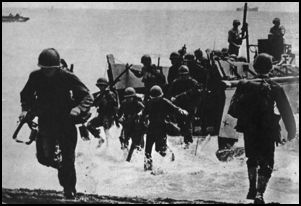
Monday, February 1, 1943
In the Solomon Islands... On Guadalcanal, US forces land at Verahue near Cape Esperance where the Japanese evacuation begins. The Americans are aware of Japanese naval activity but they believe it to be Japanese reinforcements arriving for a new offensive. In fact, 20 Japanese destroyers remove about 5000 troops. One of the destroyers is sunk by an American air attack.
On the Eastern Front... The Soviet offensive toward Kharkov continues. They capture Svatovo between Kupyansk and Starobelsk.
In Burma... British forces renew the attack on Donbaik, in the Arakan, but they do not make any gains.

Tuesday, February 2, 1943
On the Eastern Front... The northern pocket of the German 6th Army, trapped at Stalingrad, surrenders. In total, the Red Army has taken about 90,000 prisoners. Later, the Soviets announce that 147,000 Axis, and 47,000 Soviet corpses have been removed from Stalingrad. Furthermore, an estimated 40,000 were evacuated during the air supply operations conducted by the Germans, during the siege. The Luftwaffe lost about 500 transports. Only 5000 Germans taken prisoner survive to return to Germany after the war; the last to return arrives in 1955. The Soviet success is generally attributed to General Chuikov's leadership and tactical innovation.
In the Solomon Islands... On Guadalcanal the American coastal advance crosses the Bonegi River.
In the Mediterranean... The British submarine Turbulent sinks an Italian tanker near Palermo. The Italian naval squadron based in Sicily consequently remains short of fuel.
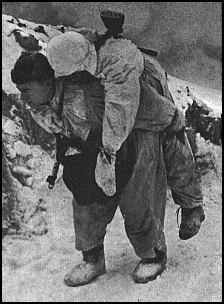
Wednesday, February 3, 1943
On the Eastern Front... In the Caucasus, the Soviets capture Kuschevka on the Soskya River, 50 miles south of Rostov. Kupyansk is captured in the offensive toward Kharkov.
In Berlin... The loss of the 6th Army at Stalingrad is made public. Three days of national mourning are set to begin on February 4th.
In the Solomon Islands... On Guadalcanal the Americans consolidate their front running inland from Tassafaronga. US patrols penetrate much closer to Cape Esperance.
Thursday, February 4, 1943
On the Eastern Front... The German 17th Army is cut off in the Kuban Peninsula and must be supplied by sea from the Crimea. Kanevskaya, to the east of Tikhorestsk and only 30 miles from the Sea of Azov, is capture by Soviet forces. Further north, Shcigny, about 40 miles east of Kursk, is captured in the southwestern offensive toward Kharkov. In North Africa... Units of the British 8th Army cross into Tunisia. In the Solomon Islands... On Guadalcanal, about 5000 more Japanese troops are evacuated by a squadron (led by Admiral Koyanagi) consisting of one cruiser and 22 destroyers. Four of the ships are damaged. Meanwhile, the US 147th Regiment advances west of Tassafaronga. In the Atlantic... Convoy SC-118 is attacked by 20 U-boats in a running battle that will last five days (to February 9th). There are ten escorts available at first.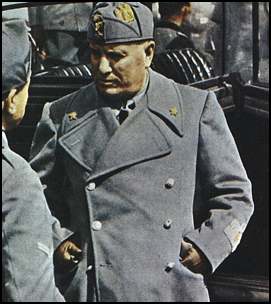
Friday, February 5, 1943
In Rome... Mussolini dismisses Count Ciano from the Foreign Ministry and takes over responsibility for it himself.
On the Eastern Front... Soviet forces capture Stary Oskol and Izyum. In the Caucasus, they make successful landings at Myoshako and are repulsed at Anopa.

Saturday, February 6, 1943
On the Eastern Front... In the Caucasus the Soviets reach Bataysk, south of Rostov, and capture Yeysk on the Sea of Azov. On the Donets River, Lisichansk is occupied and Red Army forces cross the river further upstream at Izyum, reaching Barvenkovo.
From Washington... The American command in Europe and North Africa is restructured. General Andrews is appointed to the new European Theater Command and General Eisenhower remains in command in North Africa.
In Berlin... Manstein, commanding Army Group Don on the Eastern Front, flies to see Hitler about getting approval for a retreat behind the Mius River.
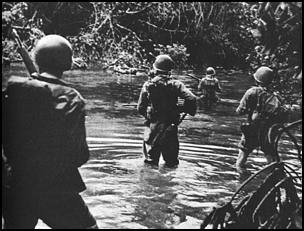
Sunday, February 7, 1943
In the Solomon Islands... On Guadalcanal the US 161st Regiment continues a cautious advance. The Japanese proceed with their evacuation.
On the Eastern Front... Soviet forces capture Azov at the mouth of the Don River. In the Ukraine they capture Kramatorsk, south of Slavyansk.
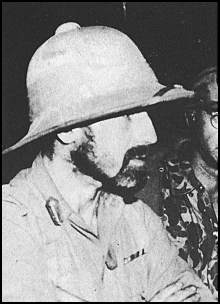
Monday, February 8, 1943
In Burma... The first Chindit raiding expedition sets out from Imphal for Tamu. The force is formally the 77th Indian Brigade under the command of General Wingate.
On the Eastern Front... Soviet forces capture Kursk.
In the Solomon Islands... The last 2000 Japanese troops are evacuated by 18 destroyers.
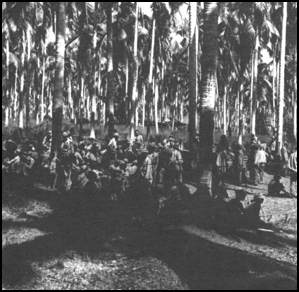
Tuesday, February 9, 1943
In the Solomon Islands... The US 161st and 132nd Regiments link up at Tenaro, too late to prevent the Japanese evacuation. The Japanese have lost 10,000 killed and the Americans have lost 1600 killed. Losses in ships and planes have been about equal. Guadalcanal has be a strategic defeat for the Japanese.
On the Eastern Front... Soviet forces capture Belgorod and the town of Shebekino to the southeast.
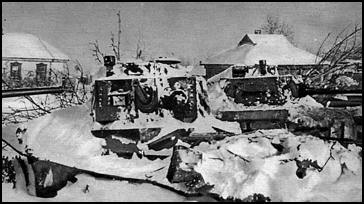
Wednesday, February 10, 1943
On the Eastern Front... Volchansk and Chuguyev are taken by the Red Army; Soviet forces are only 20 miles east of Kharkov.
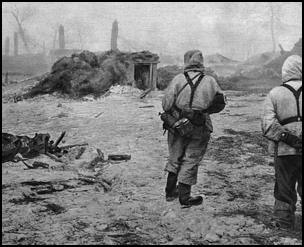
Thursday, February 11, 1943
On the Eastern Front... Soviet General Vatutin's Southwest Front captures Lozovaya.
Friday, February 12, 1943
On the Eastern Front... In the Caucasus the Soviets capture Krasnodar. To the north, west of the Don River, Shakhty, Kommunarsk and Krasnoarmeskoye are all occupied by the advancing Red Army.
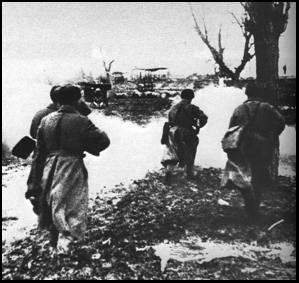
Saturday, February 13, 1943
On the Eastern Front... The Soviets take Novocherkassk.
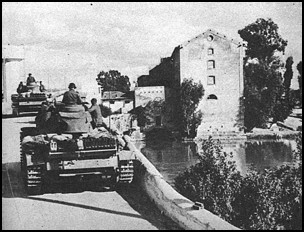
Sunday, February 14, 1943
In Tunisia... A major Axis offensive falls on the US 2nd Corps positions, west of Faid. Leading the attack are the German 10th and 21st Panzer Divisions from 5th Panzer Army (General von Arnim). General Zeigler is in immediate command.
In Burma... The Chindits cross the Chindwin River in two groups at Auktaung and Tonhe. General Wingate leads the larger northern group.
On the Eastern Front... Rostov and Voroshilovgrad are captured by Soviet forces. They also take Drasny Sulin, north of Shakhty.

Monday, February 15, 1943
In Tunisia... Troops under the command of Rommel, now commanding the Italian 1st Army, join the Axis offensive. A detachment of the 15th Panzer Division, along with Italian armor, strikes Gafsa and captures the town. Most of Rommel's forces are defending the Mareth Line where the last of the rearguard is now arriving from Libya.
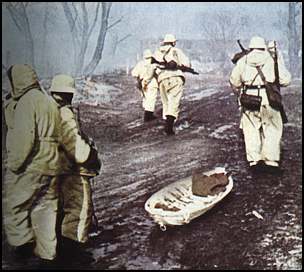
Tuesday, February 16, 1943
On the Eastern Front... Kharkov is captured by the Red Army after several days of intensive fighting on the approach to the city. General Hausser, commanding the 2nd SS Panzer Corps, chooses to withdraw from Kharkov rather than risk encirclement inside the city. This action is carried out in spite of an order, directly from Hitler, to defend the city.
In Tunisia... Forward elements of Montgomery's forces capture Medenine on the approaches to the Mareth line.

Wednesday, February 17, 1943
In Tunisia... Attacks by the forces under von Arnim and Rommel make good progress. In the north, Axis forces are approaching Sheitla, having destroyed two thirds of the US 1st Armored Division. To the south, Rommel's forces enter Feriana. Von Arnim, with limited aims in mind, diverts 10th Panzer Division toward Foundouk, which has been abandoned by its American defenders, rather than pushing toward Sbeitla. Rommel, has proposed a more ambitious plan to the Italian and German High Commands but no decision is made.
On the Eastern Front... Hitler flies to the headquarters of Field Marshal Manstein, at Zaporozhye. He stays until February 19th and will approve Manstein's plan for a counterattack.
Thursday, February 18, 1943
In Tunisia... Axis forces enter Sbeitla which has been abandoned by Allied forces. The Axis debate over following up this successful offensive continues.
From Washington... The new American 6th Army, commanded by General Krueger, become operational in the southwest Pacific.
In the Aleutian Islands... A US Task Group (Admiral McMorris) with 2 cruisers and 4 destroyers bombards Japanese positions on Attu Island.
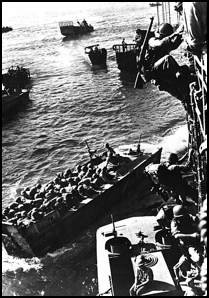
Friday, February 19, 1943
In the Solomon Islands... On Guadalcanal American reinforcements arrive as part of the buildup for the next offensive move to the Russell Islands. These islands are now reported abandoned by the Japanese.
In Tunisia... The Axis offensive is renewed with the objective of Le Kef. There are two wings to the assault. The German 15th Panzer Division attacks from Kasserine toward Thala. The 21st Panzer Division, having already advanced beyond Sbeitla, strikes toward Sbiba. The Allied command has anticipated such moves and both mountain passes are well defended. Among the Axis leadership, Rommel has proposed aiming for Tebessa instead of Le Kef and he has had elements of 10th Panzer Division placed under his command.
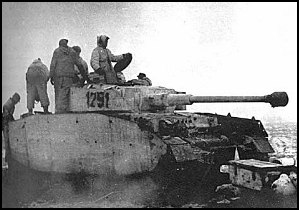
Saturday, February 20, 1943
On the Eastern Front... Red Army forces continue to advance beyond Kharkov. They capture Pavlograd during the day and are engaged in heavy fighting at Krasnograd. The salient being created by the Soviet offensive is held by strong German forces on both flanks.
In Tunisia... British and American units hold the German attack on Sbiba. Among the defending units is the British Guards Brigade. The attack through the Kasserine Pass, is initially held as well. However, the elements of the German 15th Panzer Division attacking here are reinforced with elements of the 10th Panzer Division and break through the Allied defenses. The British 26th Armored Brigade is moved up to resist the German breakthrough; nonetheless, the German forces advance to within 10 miles of Thala.
From London... Allied command in Tunisia is reorganized. British General Alexander is appointed to lead the new 18th Army Group.
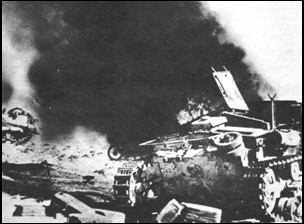
Sunday, February 21, 1943
In Tunisia... British armor holds out against attacks from the German 10th Panzer Division attempting to advance toward Thala. By the evening the front is still 3 miles south of the town. A detachment of 15th Panzer Division launches a diversionary attack on Tebessa which is strongly held by the US 1st Armored Division. The 21st Panzer Division attack toward Sbiba is stalled.
In the Solomon Islands... Operation Cleanslate. Troops of the US 43rd Division (commanded by General Hester) occupy Banika and Pavuvu in the Russell Islands. There is no Japanese resistance. By the end of the month about 9000 American troops occupy these islands.
In the Atlantic... Convoy ON-166 is attacked by U-boats over the next five days (February 21-25th). It will lose 14 ships of 85,000 tons. One German U-boat is sunk by the convoy escorts.
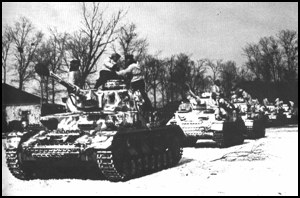
Monday, February 22, 1943
On the Eastern Front... Manstein's launches a counteroffensive to recapture Kharkov. The German 1st and 4th Panzer Armies attack northward on a line west of Krasnoarmeskoye while Army Detachment Kempf, primarily the 2nd SS Panzer Corps, drives south from Krasnodar. Manstein is generally credited with carefully handling his reserves in order to assemble the considerable forces used in the attack. Meanwhile, the Soviet forces in the salient west of Kharkov continue their advance, despite growing shortages of fuel and ammunition. One unit comes within 12 miles of Manstein's army group headquarters.
In Tunisia... A night battle develops on the front before Thala (during night of February 21-22). Both sides suffer heavy losses. At the same time, an American artillery regiment (led by General Irwin) arrives after an 800 mile march from Oran achieved in 4 days. At dawn the British, with the newly arrived American artillery support, launch a limited counterattack. The German forces pull back in the afternoon. The improved flying weather on this day is generally noted as weighing in the Allies' favor.
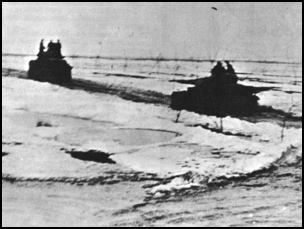
Tuesday, February 23, 1943
On the Eastern Front... The Soviets capture Sumy and Lebedin northeast of Kharkov. Meanwhile, to the south, the German counteroffensive begins to make progress. The German 48th Panzer Corps attacks toward Barvenkovo.
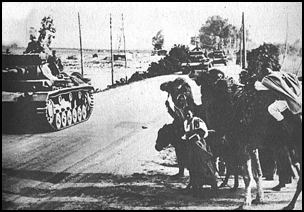
Wednesday, February 24, 1943
In Tunisia... Rommel is appointed to command Army Group Africa which is to include 5th Panzer Army (von Arnim) and Italian 1st Army (Messe). The Axis forces are withdrawing to the Eastern Dorsale.
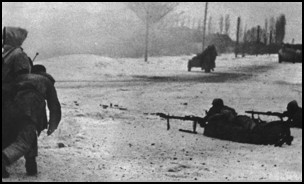
Thursday, February 25, 1943
On the Eastern Front... The Soviet offensive in the Caucasus continues. Meanwhile, in the salient west of Kharkov, Mingrelsk is captured to the east of Krasnodar.
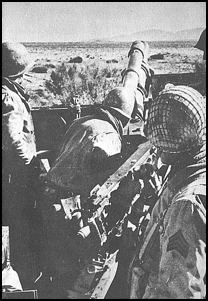
Friday, February 26, 1943
In Tunisia... Elements of 10th and 21st Panzer Divisions (parts of 5th Panzer Army commanded by von Arnim) attack British positions at Medjez el Bab. No progress is made. Rommel intends to concentrate these and other forces for an attack on the British 8th Army before the Mareth Line. Montgomery's forward units (two divisions) are vulnerable because of a lack of logistical support at the front. They are in their present positions as a diversionary move carried out as part of the response to the earlier fighting at the Kasserine Pass.
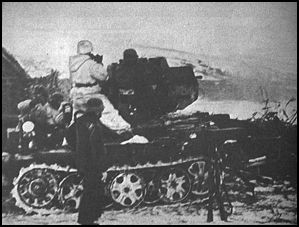
Saturday, February 27, 1943
On the Eastern Front... Manstein's forces attacking from the south are now on a line from Lozovaya to Kramatorsk.

Sunday, February 28, 1943
In Norway... The Norsk Hydro power station near Ryukan is badly damaged by a sabotage team of Norwegian soldiers who have been parachuted in from Britain. This plant is known to be in use by the Germans to produce "heavy water" for atomic research.
Copyright © 2018 Ralph Zuljan
